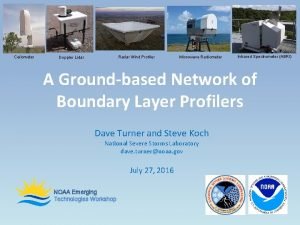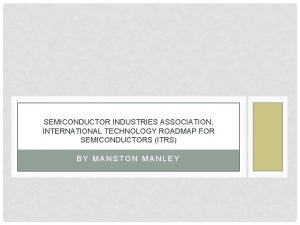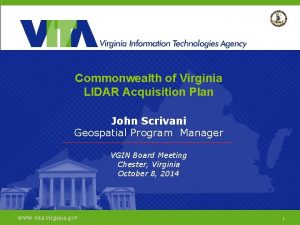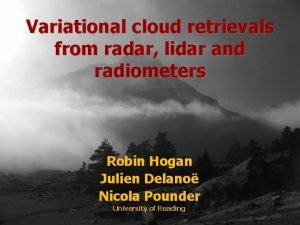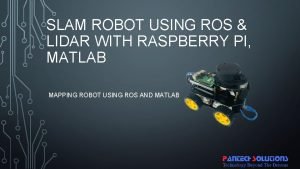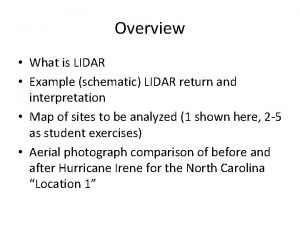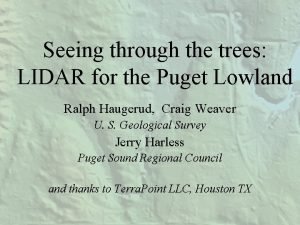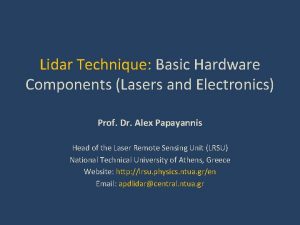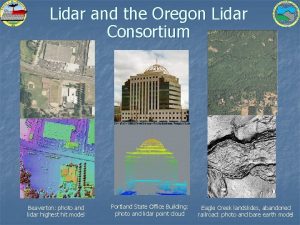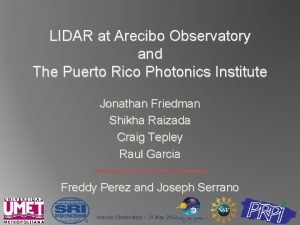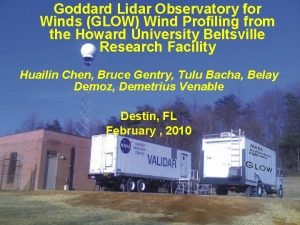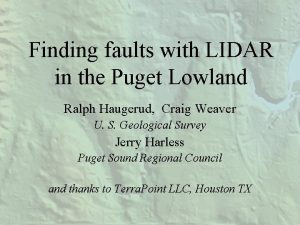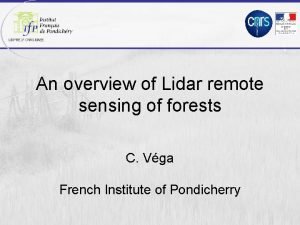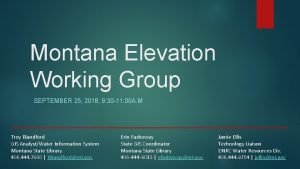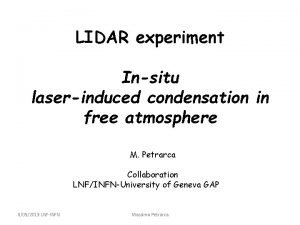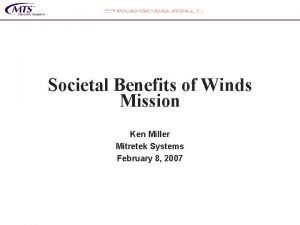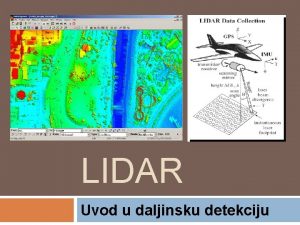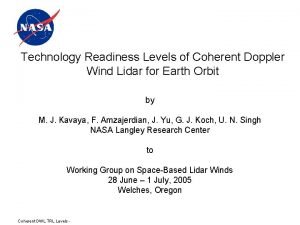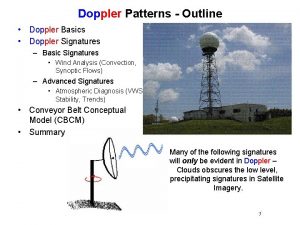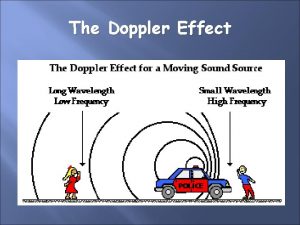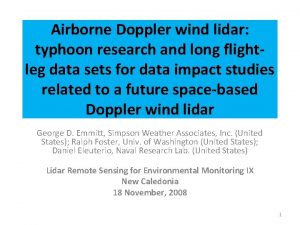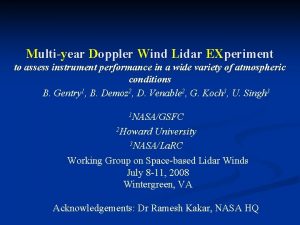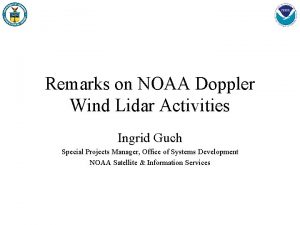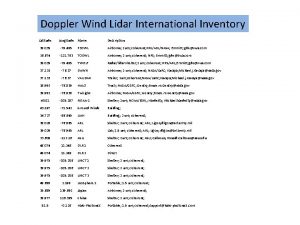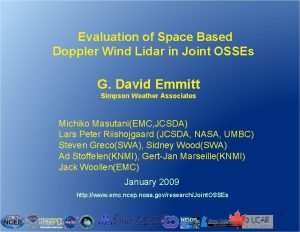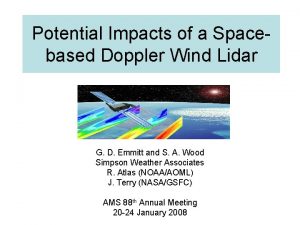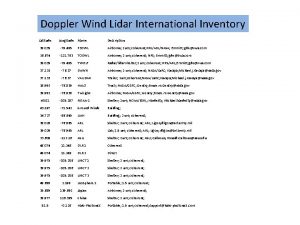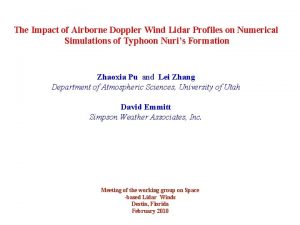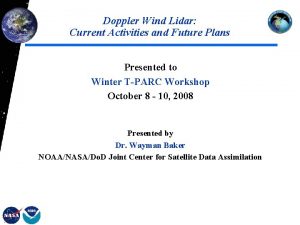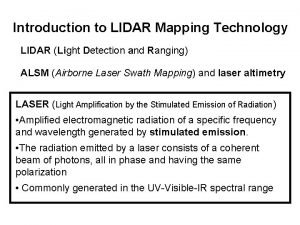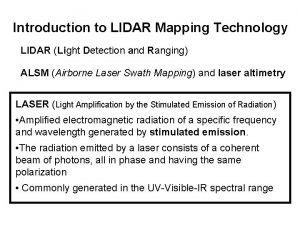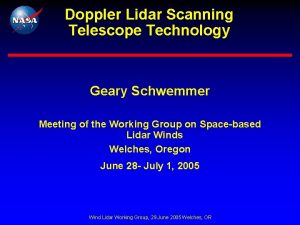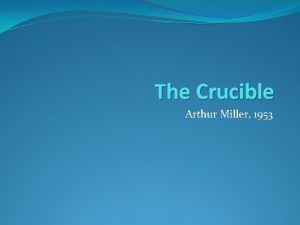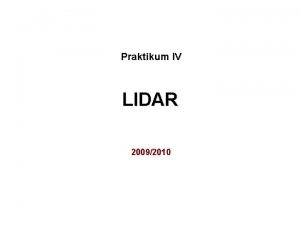Doppler Wind Lidar Technology Roadmap Ken Miller Mitretek

























- Slides: 25

Doppler Wind Lidar Technology Roadmap Ken Miller, Mitretek Systems Coauthors –see Reference 2 January 27, 2004 1

Agenda • • • Purpose and Background Measurement Concept Reference Designs Hybrid DWL Point Design Activities Leading to Operations Near Term Issues Requirements Trades Component Technology Roadmaps Conclusions Technology Readiness Time Scale References 2

Purpose • Achieve mature DWL technology and reduce risk for operational wind profiles from space • Alternative instrument approaches • Roadmaps for key technology elements assuming a hybrid instrument • Sources • Government planning document, GTWS Strategy for Obtaining Operational Wind Profiles from Space (June 2003) • Paper on Working Group Web Site: Technology Roadmap for Deploying Operational Wind Lidar (January 2004) 3

References 1. Global Tropospheric Wind Sounder (GTWS), A Strategy for Obtaining Operational Wind Profiles from Space, F. Amzajerdian, R. Atlas, W. Baker, J. Barnes, D. Emmitt, B. Gentry, I. Guch, M. Hardesty, M. Kavaya, S. Mango, K. Miller, S. Neeck, J. Pereira, F. Peri, U. Singh, G. Spiers, J. Yoe (June 20, 2003) 2. Technology Roadmap for Deploying Operational Wind Lidar, F. Amzajerdian, D. Emmitt, B. Gentry, I. Guch, M. Kavaya, K. Miller, J. Yoe, (January 20, 2004) 4

Background • Stable data requirements • Validated by OSSEs • Quantified benefits • Alternative DWL techniques • Coherent (reference designs) • Direct Detection (reference designs) • Hybrid (point design) • Need to advance technology readiness • • • Lasers Detectors Low-mass telescopes Scanners Momentum compensation 5

Background (concluded) • Current instrument activities • Demonstrating ground airborne DWLs • IPO • Airborne work on calibration/validation • Hybrid concepts • NOAA/UNH • Operating 2 Ground. Winds lidars • Developing a balloon demonstration • NASA Laser Risk Reduction Program (LRRP) • Related activities • Japanese National Space Development Agency (NASDA) • European Space Agency (ESA) 6

Measurement Concept • 45 o nadir angle • Scan through 8 azimuth angles • Fore and aft perspectives in TSV • Move scan position ~ 1 sec • No. shots averaged ~ 5 sec * prf • 4 ground tracks 7. 7 km/s 45° Aft perspective 585 km 400 km Ref: Kavaya 45° Horizontal TSV 414 km 7. 2 km/s 290 km 7

Reference Designs Belt Drive Radiator Telescope with Sunshade Rotating Deck Radiator Coherent Component Housing Direct Component Boxes Note: Large solar arrays not shown 8

Reference Designs (concluded) • • Roughly comparable cost and complexity Large and heavy spacecraft Massive optical components Extremely high electrical power consumption 9

Hybrid DWL Point Design • 2 subsystems, coherent and direct detection • End-to-end improvement vs. single DWL • Coherent subsystem: 15 to 30 X • Direct Detection subsystem: 4 to 8 X • Reduced technology requirements end-to-end • Laser power, telescope, optical efficiency, detection • Spacecraft mass, energy, momentum compensation • Should make development more tractable • But may complicate mission and spacecraft issues Emmitt (2004) 10

Activities Leading to Operations Data Requirements & Tradeoffs Achieve Technology Readiness Architecture Concepts Ground & Airborne Demos Space Demonstration Develop Operational Mission Launch 11

Near Term Issues • Technology development • Data requirements vs. benefits trade study • Architecture concepts • • Hybrid reference design Calibration and validation Mission and spacecraft alternatives Impacts on data products from atmospheric properties, DWL alternatives, and spacecraft mechanics 12

Requirements Trades Threshold Requirement Technology Risk Impacts Mechanism Vertical TSV 1 Resolution (1 km) Laser, detector, telescope Increasing vertical TSV dimension increases photon accumulation Horizontal TSV Dimension (100 km) Laser, detector, telescope, scanner Increasing horizontal TSV dimension, combined with relaxing horizontal resolution would allow more shot accumulation and simplify scanner Horizontal Resolution Along Track (350 km), Laser, detector, telescope, scanner Increasing beyond 350 km increases time for shot averaging and scanner movement Horizontal Resolution – Cross-Track (4 lines) Laser, detector, telescope, scanner Less Cross-Track observation lines increases time for shot accumulation and scanner movement 2 discrete perspectives in TSV Scanner Consider non-discrete method, e. g. , conical scan Wind Velocity Accuracy Laser, telescope, detector Reduced accuracy reduces laser, optics, and detector requirements 1 Target Sample Volume (TSV) is the maximum atmospheric volume averaged in a single wind observation 13

Component Technology Roadmaps Technology Development Direct Coherent Hybrid Detection Laser X X X Optical Filters X Telescope and Scanner X X X Detectors, Arrays, Efficiency X X X Pointing Technology X X X Tunable LO Laser X X Autoalignment X X X Hybrid Ref Designs X Hybrid Integration Designs X 14

Direct Detection Component and Subsystem Development and Demo Component Technologies Tunable etalon filters Subsystems Field measurements Single frequency lasers Photon counting detectors Doppler lidar receivers Novel receiver optics Fiber coupled telescopes Holographic scanners 1. Evaluate components 2. Establish performance criteria/ specs 1. Evaluate subsystem designs/ concepts 2. Interface issues/answers 3. Environmental sensitivities 1. Measurement heritage/experience 2. Algorithm development 3. Evaluate atmospheric effects 4. Link technology performance to science product - winds 5. Develop robust instrument models Gentry (2003) 15

Direct Detection Subsystem Laser Performance Objectives Material All solid state Pulse characteristics 1064 nm 1 to 3 J 20 ns pulse length 10 -100 Hz < 200 MHz bandwidth @ 355 nm > 35% harmonic conversion to 355 nm Lifetime > 5 x 109 shots Mass Low (tbd) Power Low (tbd) Wallplug efficiency 6 to 8% Cooling Conductive Gentry (2003) 16

Laser Roadmap – Direct Detection Subsystem LRRP Diode array life test/qualification Single frequency, 30 W, frequency tripled, partially Conductively-Cooled 1 -Micron Laser l 1 Non-linear optics testing 2 l Flight Qualified All Conductively-Cooled 1 Micron Laser Thermal Management 3 l Materials testing (radiation, uv exposure, optical damage ) Ground Lidar Validation Airborne Lidar Validation Space Lidar Demonstration Space Operational Mission Primary Path Secondary Path Completed Item In Progress 1 l Milestone Gentry (2003) 17

Telescope Roadmap – Direct Detection Subsystem Mechanical Rotating Telescope/ Scanner l 1 Rotating HOE or DOE Telescope/Scanner l 2 Lightweight Materials 3 l Ground Lidar Validation Advanced concepts (e. g. deployables) Airborne Lidar Validation Space Lidar Demonstration Space Operational Mission Primary Path Secondary Path Completed Item In Progress 1 l Milestone Gentry (2003) 18

Pointing Technology Roadmap – Direct Detection Subsystem INS/GPS Telescope-to-Optical Bench Alignment Sensor l Surface Return Algorithm Ground Lidar Validation Star Tracker l Validation Airborne Lidar Space Lidar Demonstration Target: 0. 2 deg pre-shot pointing knowledge Space Operational Mission 50 mrad final pointing knowledge Primary Path Secondary Path Completed Item In Progress 1 l Milestone Gentry (2003) 19

Laser Roadmap – Coherent Subsystem All Liquid-Cooled 2 -Micron Laser Partial Conductively-Cooled 2 -Micron Laser l All Conductively-Cooled 2 -Micron Laser Ground Lidar Validation Airborne Lidar Validation Space Lidar Demonstration Space Operational Mission In Progress Primary Path Secondary Path Completed Item l Progress Mark Amzajerdian, Kavaya (2003) 20

Scanning Subsystem – Coherent Subsystem Rotating Wedge Scanner l Telescope Scanner Rotating Electro-Optic Scanner l Ground Lidar Validation Airborne Lidar Validation Space Lidar Demonstration Space Operational Mission In Progress Primary Path Secondary Path Completed Item l Progress Mark Amzajerdian, Kavaya (2003) 21

Pointing Roadmap –Coherent Subsystem Pointing target performance • 0. 2 degrees pre-shot pointing knowledge • 50 µrad final pointing knowledge l Telescope-to-Optical Bench Alignment Sensor INS/GPS Surface Return Algorithm Ground Lidar Validation Star Tracker l Validation Airborne Lidar Space Lidar Demonstration Space Operational Mission In Progress Primary Path Secondary Path Completed Item Amzajerdian, Kavaya (2003) l Progress Mark 22

Additional Component Technology Roadmaps • See Reference 2 23

Conclusions • Technology development comes first • • • Lasers Detectors Low-mass telescopes Scanners Momentum compensation) • Data requirements vs. benefits trades may reduce technology development time • Architecture concepts – some near term areas • • Hybrid reference design Calibration and validation Mission and spacecraft alternatives Impacts on data products from atmospheric properties, DWL alternatives, and spacecraft mechanics 24

Technology Readiness Time Scale • Funding levels, technology advances • Longest lead time estimates • Flight qualified lasers – 4 years • Electro-optic scanners – up to 6 years 25
 Lidar wind profiler
Lidar wind profiler Miller index examples
Miller index examples Daniel miller arthur miller
Daniel miller arthur miller Medical plaza miller 131 miller street
Medical plaza miller 131 miller street Kurshalter
Kurshalter Win ccoa
Win ccoa Semiconductor industry association
Semiconductor industry association Semiconductor technology roadmap
Semiconductor technology roadmap International roadmap for semiconductors
International roadmap for semiconductors Semiconductor technology roadmap
Semiconductor technology roadmap Virginia lidar
Virginia lidar Radar lidar
Radar lidar Raspberry pi slam
Raspberry pi slam Lidar schematic
Lidar schematic Blinder xtreme 7 series
Blinder xtreme 7 series Pessoas que se sentem superiores
Pessoas que se sentem superiores Puget sound lidar consortium
Puget sound lidar consortium Lidar system component
Lidar system component Lidar consortium
Lidar consortium Ddpulse
Ddpulse Lidar puerto rico
Lidar puerto rico Lidar
Lidar Puget sound lidar consortium
Puget sound lidar consortium Lidar
Lidar Montana lidar inventory
Montana lidar inventory Lidar
Lidar
